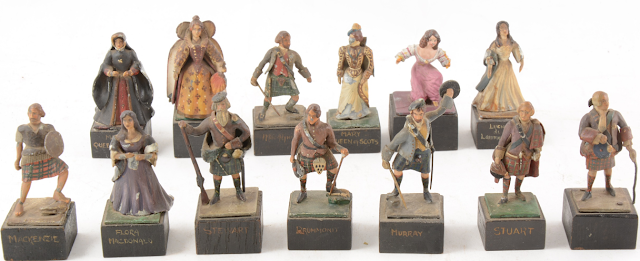It always seems to be feast or famine at the local car boot sale but last weekend I managed a reasonable haul:
When I have a little money, I buy Toy Soldiers; and if I have any left, I buy food and clothes. (with apologies to:) ERASMUS
Friday, 11 October 2024
Fleamarket finds from the weekend.
Saturday, 5 October 2024
Medieval Lord and Lady - but who made them?
After the success I had on facebook with the identification of the Galloglass made by Oojah-Cum-Pivvy I thought I'd try the same approach to find the origin of these rather fine figures. I believe they were made in England, 54mm tall, they are made from some sort of composition material, they may have been made for a toy theatre or something like that.
Saturday, 21 September 2024
Malcolm III and William Rufus 1093 - Battle Ravens
Since discovering that the boardgame Battle Ravens translates so well to the tabletop for a wargame with 54mm toy soldiers we thought we'd give it another outing.
Our first trial of the game was a standard shieldwall encounter between Vikings and Saxons, but the game also offers sets of cards to portray the national characteristics of Scots, Welsh and Normans so we decided to try something different.
For a scenario I chose the border raid in 1093 by the Scots of Malcolm III, in support of Saxon refugees, against a frontier outpost held by the Normans of William Rufus.
Tuesday, 17 September 2024
Romans by Frederick Ping
A lucky find at the local car boot sale were these two rather undersized Romans, 50mm and solid lead, they've both seen better days and are now rather scuffed but I could see from what remained that they were once figures of quality.
Under the wooden base I could just make out the words: Hummel Burlington Arcade London W1, which translates as "Expensive!" For those who've never been there, Burlington Arcade, off London's Piccadilly, is an avenue of eye wateringly expensive shops, one of which was Hummel's where you could buy exclusive connoisseur model figures made by the likes of Richard Courtenay and Frederick Ping.
Friday, 6 September 2024
Jacobite Rebellion - One Hour Wargames
Subsequent to this year's Plastic Warrior Show, Anthony has acquired the greater part of a Jacobite 54mm wargames collection created by our old friend Eric Kemp. Needless to say, we couldn't wait to get them out on the table. We turned to our default ruleset for such games, One Hour Wargames by Neil Thomas and selected Scenario 6 - Flank Attack.
This post is really a shameless opportunity to show off some very pretty toy soldiers, for which I offer no apology!

































